Albatrellus subrubescens (Murrill) Pouz.
Phylum: Basidiomycota - Class: Agaricomycetes - Order: Russulales - Family: Albatrellaceae
Distribution - Taxonomic History - Etymology - Identification - Culinary Notes - Reference Sources
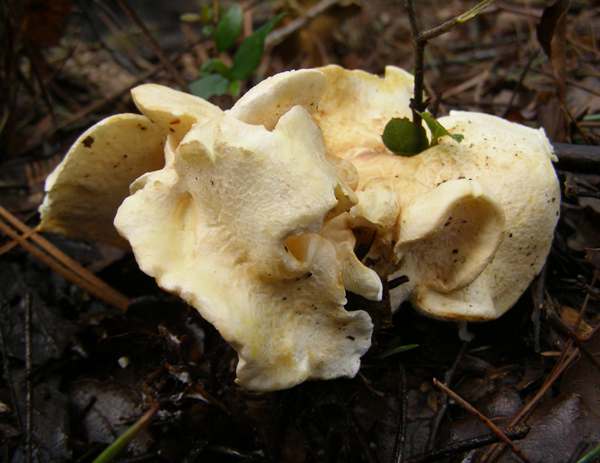
Seen from above these slightly rufous polypores, not known to occur in Britain and Ireland but fairly common in some European mainland countries, cold be mistaken for Terracotta Hedgehogs, Hydnum rufescens. Often, however, the caps are so distorted that they look more like crumpled brown paper bags.
Some authorities believe that this edible mushroom may be mycorrhizal with conifers, and in particular with spruce trees.
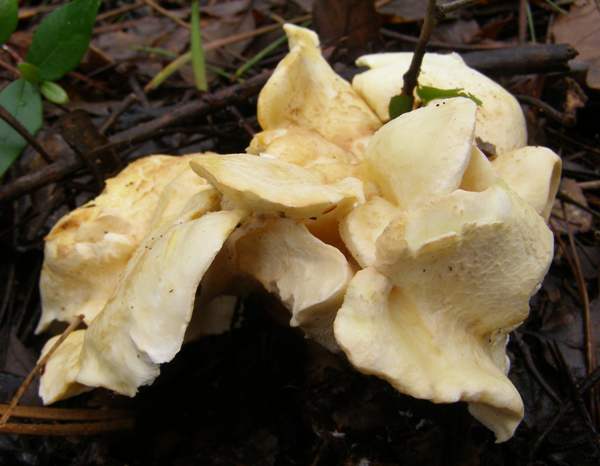
Distribution
Uncommon to rare on mainland Europe, mostly in the central and southern regions. This species is also reported from temperate parts of Asia and North America, but it is easily confused with other similar species. In particular it is very difficult from macroscopic characters alone to differentiate between Albatrellus subrubescens and Albatrellus ovinus, the Forest Lamb or Sheep Polypore. Albatrellus subrubescens turns reddish-orange when bruised, whereas Albatrellus ovinus hardly changes at all. Microscopic investigation is more conclusive, however: the spores of Albatrellus subrubescens are amyloid - the walls of its spores stain bluish-black to black when immersed in Melzer's reagent, whereas spores of Albatrellus ovinus are inamyloid (do not react to Melzers reagent). Another difference is that the spores of Albatrellus subrubescens are warty, whereas the spores of Albatrellus ovinus are smooth.
First described in 1940 by American mycologist William Murrill (1869 - 1957), who gave it the scientific binomial name Scutiger subrubescens, this species was transferred to the genus Albatrellus in 1965 by Czech mycologist Zdeněk Pouzar (born 1932).
Taxonomic history
Synonyms of Albatrellus subrubescens include Scutiger subrubescens Murrill, Polyporus subrubescens (Murrill) Murrill, Albatrellus similis Pouz., Scutiger ovinus var. subrubescens (Murrill) L.G.Krieglst., and Albatrellus ovinus var. subrubescens (Murrill) L.G.Krieglst.
Etymology
Albatrellus, the genus name, is not so easy to see through, and I am grateful to Philip Rogosky for what follows: S F Gray explicitly attributes his Albatrellus to Pier Antonio Micheli's Albatrello. The first two vernacular names Micheli reports reference the strawberry tree Arbutus unedo - in Italian "corbezzolo", which in Micheli's region/dialect was (and still is) know as "albatro"/"arbatro", so they're a record of common associative names for the mushroom: the "strawberry tree mushroom". (He actually specifies that it also appears in chestnut groves.) However: Micheli actually intended another mushroom entirely: he was describing either the birch bolete / scaber stalk Leccinum scabrum or more likely perhaps Leccinellum pseudoscabrum, or even Leccinum aurantiacum. So... Gray picked up Micheli's strawberry-tree nomer, and stuck it onto the "fir plantation"-loving Forest Lamb/Sheep's Foot, unaware that it actually originally meant another associated tree altogether - and another mushroom!
The specific epithet subrubescens means becoming reddish, and indeed some people call this the Redenning Polypore.
Identification guide
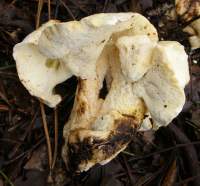 |
Cap7 to 18cm across, cream with rufous and violet tinges, turning orange when bruised; convex, soon flattening and becoming centrally depressed, distorted and lobed; margin wavy and usually remaining incurved; skin cracks when old or in very dry weather. Often several caps merge and become firmly conjoined. StemCreamy white or slightly rufous, turning orange where bruised; 3 to 7cm tall, 1 to 3cm diameter. |
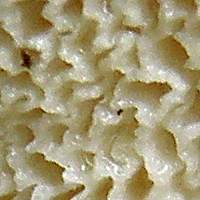 |
PoresWhite or creamy yellow; irregularly oval; tubes decurrent; 2 to 3 per mm. |
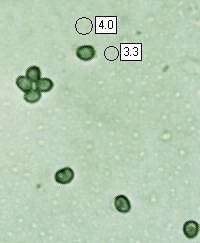 |
SporesEllipsoidal to ovoid, 3.4-4.7 by 2.2-3.4 µm; amyloid (readily separating this species from Albatrellus ovinus, whose spores are inamyloid), finely warty. Spore printWhite. |
Odour/taste |
Not significant. |
Habitat & Ecological role |
In woods, often under conifers. |
Season |
July to December. |
Similar species |
Albatrellus ovinus has a paler cap surface, and it does not turn orange when bruised. Confident differentiation of these two very similar species requires microscopic examination of the spores, which are amyloid in Albatrellus subrufescens but inamyloid in Albatrellus ovinus. |
Culinary Notes
This is one of the very few polypores with a tradition of culinary popularity... if you happen to live in Finland, that is, for there it (together with its close relative Albatrellus ovinus) is sold commercially in large quantities. Elsewhere the local field guides seem for the most part to offer a vague 'generally considered edible' but without advice of recipes. Despite having numerous opportunities to gather these chunky woodland fungi on mainland Europe, we have not yet tried them and so we are unable to comment from first-hand experience. In texture they are very similar to Hydnum repandum, the Wood Hedgehog, which we find delicious in all sorts of dishes from soups and risottos to our own favourite invention which we call 'Hedgehogs on Toast'.
Reference Sources
Fascinated by Fungi, 2nd Edition, Pat O'Reilly 2016, reprinted by Coch-y-bonddu Books in 2022.
BMS List of English Names for Fungi
Dictionary of the Fungi; Paul M. Kirk, Paul F. Cannon, David W. Minter and J. A. Stalpers; CABI, 2008
Taxonomic history and synonym information on these pages is drawn from many sources but in particular from the British Mycological Society's GB Checklist of Fungi.
Fascinated by Fungi. Back by popular demand, Pat O'Reilly's best-selling 450-page hardback book is available now. The latest second edition was republished with a sparkling new cover design in September 2022 by Coch-y-Bonddu Books. Full details and copies are available from the publisher's online bookshop...

